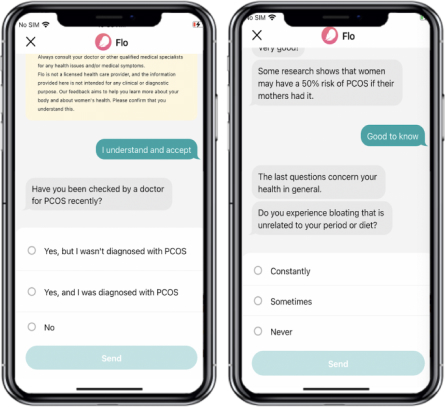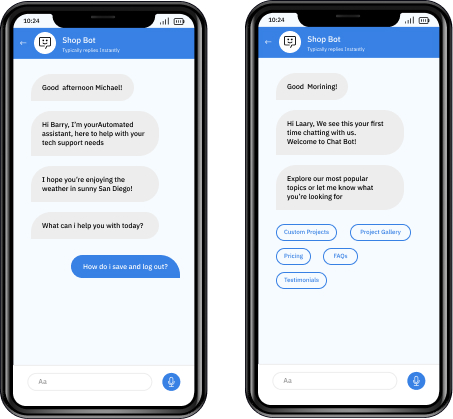Conversational Messaging: CX benefits and best practices
September 16, 2021 | Read Time : 3 mins
Table of Contents
What is conversational messaging?
Conversational messaging is a form of a one-on-one conversation between a brand and customer that could happen on any messaging platform or directly through the company site.
It’s a type of personal communication with a business executive that provides the customers with an assurance of the brand and allows them to have their queries resolved as soon as possible.
Conversational messaging can be initiated through Chatbots, WhatsApp, Facebook, Twitter, or any other messaging platform. It is a human way of connecting with your customers.
Examples:

How is conversational messaging different from live chatting?
Messaging allows a more personal, individual, and immediate perspective on things through communication between company and customer on various messaging platforms.
It will enable conversations to be saved and appear more unique and personalized according to each customer. It makes customers want to trust the brand when they know a person on the other end immediately responds to their query.
Live chat, on the other hand, is where the customer is likely to have to wait for an executive to respond. If not answered in a given amount of time, the session expires, requiring the customer to start over again. Customers now expect conversational messaging as part of their customer experience.
“I think chatbots are the future of engagement between a fan and a brand or celebrity.”
– Christina Milian, Forbes
Significance of conversational messaging in business
Messaging has now become an unavoidable part of our daily lives, forming how individuals communicate with one another. As of April 2021, social media platforms have about 300 million or more monthly active users. Facebook messenger has around 1.3 billion monthly users, WhatsApp has approximately 2 billion monthly active users, and WeChat has around 1.25 billion monthly users. (via https://datareportal.com/social-media-users)
Allowing customers to connect with the business via their channel will enable conversations to be more frequent and insightful.
Here are a few reasons to consider conversational messaging as a step towards success for your business. These especially stand out and provide a better user experience:
- Provides personal experiences through the customer journey
Customer journey includes
a) customer coming across your product
b) answering a question related to the product, like specific needs
c) post-purchase customs like delivery, discounts, etc.
In all these steps messaging is an excellent way for quick, easy communication with customers, ensuring two-way participation.
- Building customer relationships
Conversational messaging allows customers to engage with businesses more simply and quickly and builds a certain level of trust. It is also the best way to showcase your brand and personality by creating a unique experience for each customer.
- Stimulate customer engagement
Customers expect to be responded to almost immediately. Conversational messaging implies that customers can engage and get replies irrespective of where they are. Customers want it to be known that time is of utmost importance to them.
- Provide positive customer experiences
Creating a more human experience is key to customer experience. By personalizing the customer experience and stimulating experience, businesses can create a positive environment for natural and smooth engagement.
How does it affect CX and UX?
Conversational messaging UX combines chat, voice, or any language-based conversation that would mimic human behaviour. Customer experience is about having meaningful conversations with customers.
The point of CX is to be conversational in design. Because conversational messaging is about engaging with customers and understanding their needs and requests, it paves the way to a positive CX when their queries are resolved.
Using conversational messaging adds to the UX of a company website or application. It creates a more personalized section for users where each customer would have a unique User Experience. A great conversational UX would feel like a conversation between two real people, even if one of them isn’t real. It is this realness that enhances the UX that customers go through. Improved UX leads to a better customer experience.
What are some solutions provided by
Conversational Messaging companies?
Companies like Intercom, Attentive, and Smooch are examples of those who provide and produce a messaging platform for businesses.
Let’s look at some solutions provided by these companies:
Intercom
Intercom is an American software that produces a messaging platform that allows companies to communicate with potential and existing customers.
- Intercom provides more efficient human support by allowing the customer to chat in real-time with businesses and get back to them later. These conversations can also be managed very easily by being stored irrespective of where they are happening.
- Provides helpful customer information and helps prioritize better and route conversations.
- Intercom promotes conversational customer engagement. The onboarding feature allows new customers to speed up with helpful messages and tours from inside the product itself.

- Customers can share automated messages or use attention-grabbing posts for more important updates. Users are guided through the app with step-by-step notifications to provide the best experience.
- They have more intelligent routing and lead qualifications. Custom bots ask the right questions to prioritize and route new conversations. These bots work for the customer all day, ask questions, and deliver qualified leads when they are live.

Smooch or Sunshine
Smooch or Sunshine Conversations is a software that standardizes communications across social messaging platforms and its web and mobile software development kits.
Businesses can follow a conversation thread from any messaging channel while providing customers with a consistent experience.
- The API gives users access to all WhatsApp Business features. When users reply to a notification, Sunshine Conversations’ WhatsApp integration provides agents with the original notification, giving them the context they need to continue the conversation seamlessly.
- It covers all the channels from Facebook messenger to SMS, RCS, pushes, and email and ensures that every message gets delivered. Customers can connect multiple systems to the WhatsApp conversation stream.
- It helps build omnichannel messaging in the software. Companies have access to the richest features across the broad set of channels.
- Companies can build bots on any platform. Customers can be reached irrespective of where they are. Full conversation history and past interactions can be leveraged to improve customer experience.


What is the role of a conversational designer?
Conversational designers craft a digital language for your bot, deciding how many humans would interact with it, using voice and text as inputs. They design the User experience of a virtual assistant by ensuring that the assistant is engaging, immediate, and impactful for the user on the other end. The first impression created is the best impression for virtual assistants as well.
A conversational designer thinks like a user experience designer by thinking about the user’s thought process, problems, and solutions. The role of a conversational designer is to make space feel more personal and make it comfortable for the user to engage. It is to create the flow of things for the user and which paths the conversation should take.
A conversational designer essentially has 4 roles :
- UX designer
- Copywriter
- AI trainer
- Product designer
What are some solutions provided by
Conversational Messaging companies?
Any UX design comes with a set of practices that can be followed. Because UX is the main focus of conversational messaging, the user experience must be the best when the user is interacting with the messaging feature on your company website.
- Customer consent
It is always essential that companies provide an opt-out option and choose if and where to receive messages. Respecting customers’ opinions and choices helps build trust and commitment between the company and customers.
- Understand customers
Conversations with your customers should give you an insight into their minds. Using these insights would help you understand your customer’s various aspects, such as when they are active and what they like (or dislike) about your company.

- Customize messages
Every customer should be catered to separately and uniquely. No two customers would have the same queries, so it is vital to customize responses from person to person.

- Keep track of history
Provide history from previous conversations as a landmark so that the users know where they left off. It assures that the company knows customer queries and that someone is looking to resolve them.

- Onboard Users
Conversational agents should convey what they are capable of doing, like what they are there for and what kind of help they can provide. Great onboarding often creates an excellent first impression on customers, providing positive UX from the start.

What do customers expect from conversational messaging?
Through conversational messaging, customers expect to be understood and communicated with better than through something like email. Because these conversations happen pretty much on the spot and answers to questions are provided almost immediately, they’d expect that this expert on the other end should have a clear idea of what they are talking about. Your customer wants to know that their opinion matters to you and that you as a brand would cater to it. Consumers want the convenience that only digital businesses can offer.
What is the future of conversation design?
The conversation is the medium via which we negotiate and form bonds with others. It’s fundamentally a team effort, a shared achievement with your client. Every conversation is an opportunity to create a relationship with a new consumer or deepen bonds with an existing customer. Conversation design is used by successful companies to reduce pain points and increase consumer confidence. The rewards for smart conversation design are high.






